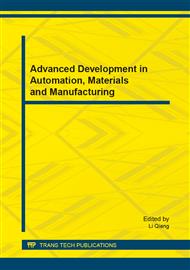p.393
p.397
p.401
p.405
p.410
p.417
p.424
p.429
p.433
Research of Novel Phosphor Membrane Packaging Technology for LED Illuminant
Abstract:
A ultra-thin phosphors membrane which realized a good matching of the SMD bracket was prepared by the silk screen printing technology, and the white LED illuminant with the ultra-thin phosphors membrane had a significant advantage over the traditional packing production. The experiment results indicated that the white LED of conventional color rendering index made by membrane packing technology had the same luminous efficiency with the standard sample, while it had an obvious advantage in luminous decay. In 3000 hours, the luminous decay of the white LED illuminant made by membrane packing technology was less than 2%, better than the standard sample with the luminous decay of 3%. The luminous efficiency of the high color rendering index white LED illuminant made by membrane packing technology was higher about 3% than the standard sample; also the luminous decay performance was outstanding.
Info:
Periodical:
Pages:
410-414
Citation:
Online since:
August 2014
Authors:
Price:
Сopyright:
© 2014 Trans Tech Publications Ltd. All Rights Reserved
Share:
Citation:


